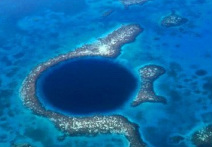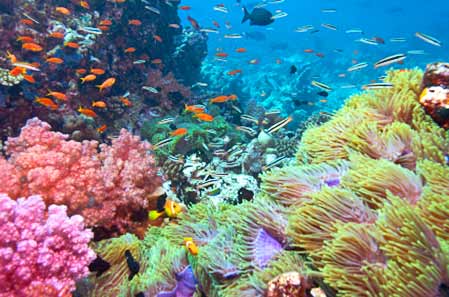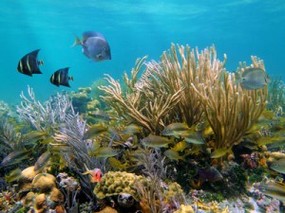Throughout my years of traveling I have had the opportunity to dive at some of the world’s best diving spots like the Great Barrier Reef, the Red Sea, and Fiji. After a recent trip to Central America I was amazed by the reef off of Belize. Amazed enough that I would say Belize belongs on every scuba divers bucket list.
Belize has the longest barrier reef in the Northern Hemisphere and offers a combination of gentle inshore scuba diving and some more adventurous oceanic dive sites for the experienced divers. Divers are treated with a heady concoction of reef, wall, cavern and caye diving experiences. And unlike most of the Australian Great Barrier Reef, the Belizean Barrier Reef is alive and full of colors and sea life. On top of that the reef has fewer crowds and regulation so it’s easier to explore. If all that wasn’t enough diving in Belize also costs heaps less compared to diving at other top dive destinations.
Belize has the longest barrier reef in the Northern Hemisphere and offers a combination of gentle inshore scuba diving and some more adventurous oceanic dive sites for the experienced divers. Divers are treated with a heady concoction of reef, wall, cavern and caye diving experiences. And unlike most of the Australian Great Barrier Reef, the Belizean Barrier Reef is alive and full of colors and sea life. On top of that the reef has fewer crowds and regulation so it’s easier to explore. If all that wasn’t enough diving in Belize also costs heaps less compared to diving at other top dive destinations.
The barrier reef is about 174 miles (280 km) long extending all the way along the coast of the Yucatan Peninsula in the north to Honduras in the south. In this way, the reef actually creates a true barrier between the ocean and the coast thus providing calm waters to scuba dive in. There are also numerous islands dotting the reef which are called Cayes in this part of the world. In the south eastern part of the reef, there is a large depression in the ocean floor of the Caribbean Sea and this created 3 atolls called Glovers, Turneffe and Lighthouse. These atolls rise close enough to the surface to allow sunlight penetration causing massive coral and sponge growths which create a stunning landscape.
While diving the atolls I was constantly amazed at the abundance of sea life such as eagle rays, sharks, turtles, dolphins, manatees, and moray eels. The water was warm and the visibility seemed endless. And it wasn’t just the sea life that was impressive. I was used to boring colorless coral found at most dive sites but I was completely in awe of the color and beauty of this reef. Some of the sponges are more than a century old and can measure up to an awesome 6 ft or 2m across!
While diving the atolls I was constantly amazed at the abundance of sea life such as eagle rays, sharks, turtles, dolphins, manatees, and moray eels. The water was warm and the visibility seemed endless. And it wasn’t just the sea life that was impressive. I was used to boring colorless coral found at most dive sites but I was completely in awe of the color and beauty of this reef. Some of the sponges are more than a century old and can measure up to an awesome 6 ft or 2m across!

And then there is the iconic Belizean Blue Hole which was brought to prominence by Jacque Cousteau's famous research vessel Calypso in the 1970's. Located off Ambergris Caye and formed about 15,000 years ago, the Great Blue Hole is a limestone cave system that collapsed into a sinkhole over 400 feet deep. This is an amazing dive site!
My experience at the Blue Hole was everything I expected and more. Although this dive isn’t known for its abundant sea life, as soon as we got in the water we were surrounded by dozens of Caribbean reef sharks and a couple bull sharks which was a nice surprise. Approaching the shallowest cave systems at about 30m we could see stalactites that were 1m in diameter and up to 6m in length. Fallen stalactites litter the floor of the cave 15m below and mark the entrance to a cavern system which adds an eerie feel to this already distinctive dive.
A week of Belize diving and it’s now one of my favorite dive destinations. With over 500 species of fish, larger marine animals such as manatees, whale sharks, manta rays, and reef sharks, Belize is a premier diving destination that is a must for scuba diving enthusiasts.
My experience at the Blue Hole was everything I expected and more. Although this dive isn’t known for its abundant sea life, as soon as we got in the water we were surrounded by dozens of Caribbean reef sharks and a couple bull sharks which was a nice surprise. Approaching the shallowest cave systems at about 30m we could see stalactites that were 1m in diameter and up to 6m in length. Fallen stalactites litter the floor of the cave 15m below and mark the entrance to a cavern system which adds an eerie feel to this already distinctive dive.
A week of Belize diving and it’s now one of my favorite dive destinations. With over 500 species of fish, larger marine animals such as manatees, whale sharks, manta rays, and reef sharks, Belize is a premier diving destination that is a must for scuba diving enthusiasts.



 RSS Feed
RSS Feed

